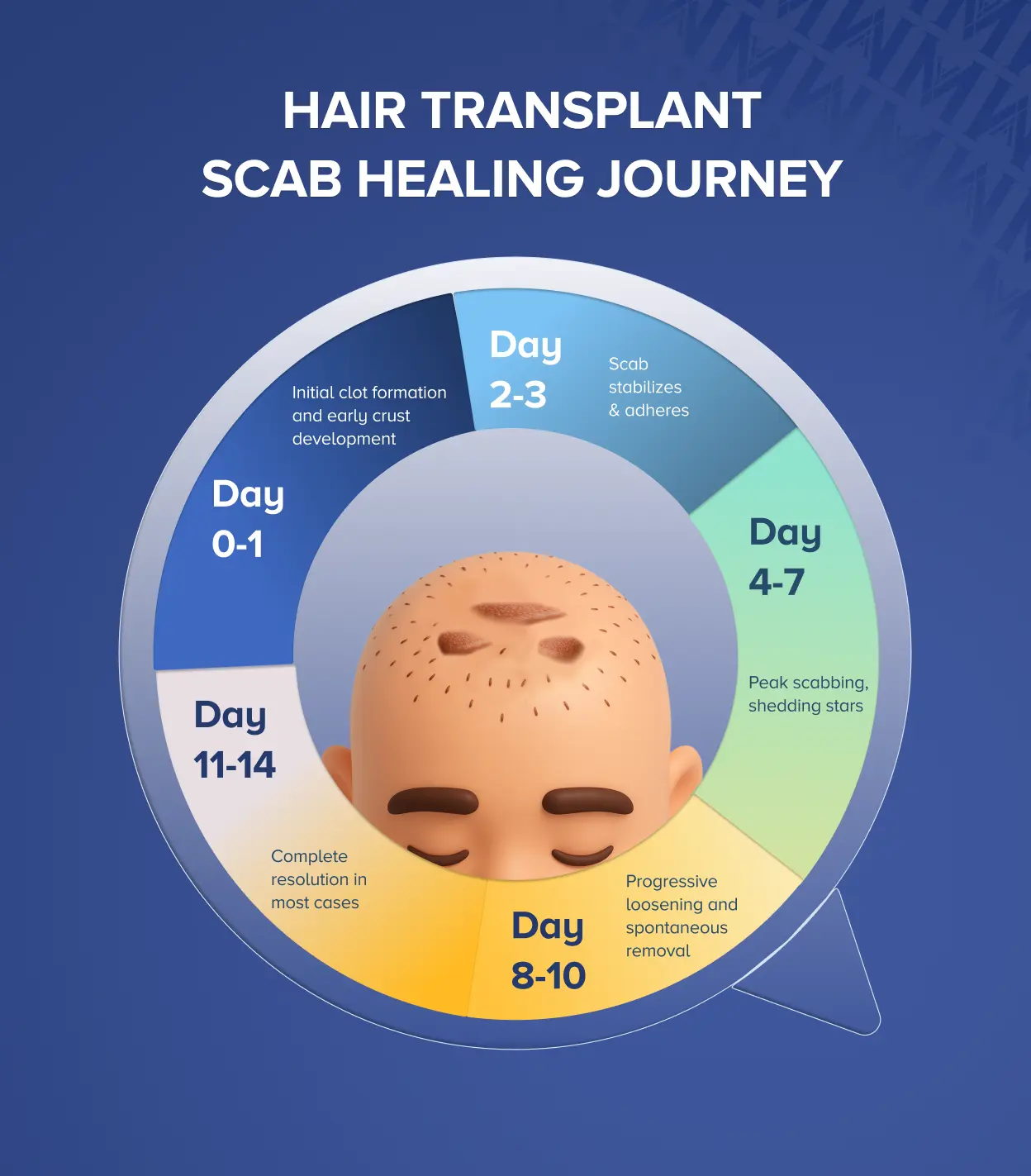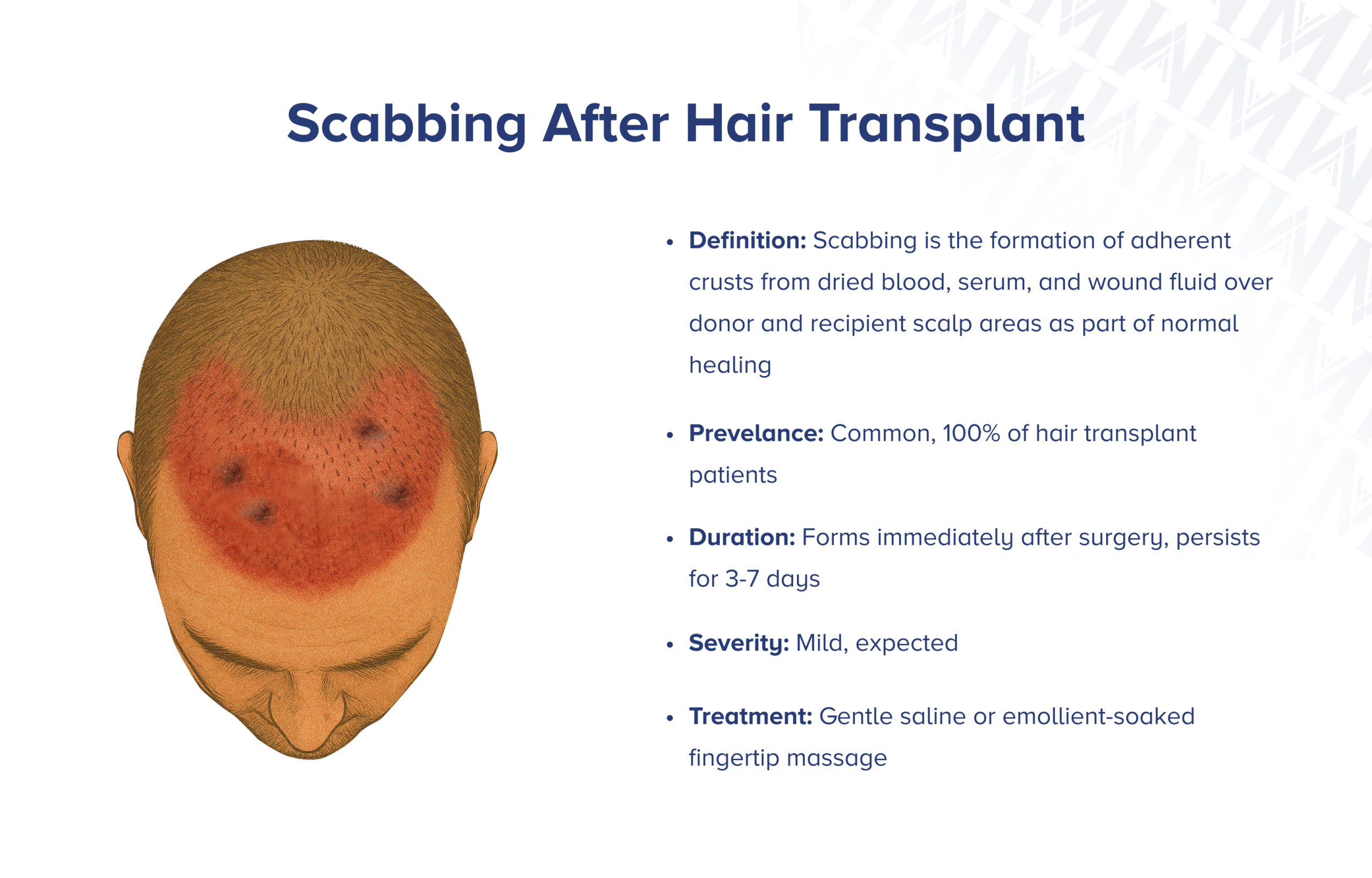Hair transplant scabs develop after every follicular unit extraction (FUE) or follicular unit transplantation (FUT) procedure, affecting 100% of patients during the initial healing phase. These protective crusts, composed of dried blood and wound exudate, represent the body's natural healing response rather than a surgical complication.

While hair transplant scabs are completely normal and expected, proper management during the critical 7-10 day formation period directly impacts graft survival and final aesthetic results. Understanding the difference between normal scab progression and warning signs requiring medical attention ensures optimal hair restoration outcomes through evidence-based post-operative care protocols.
Key Points
- Hair transplant scabs occur in 100% of patients as part of natural wound healing after FUE and FUT procedures.
- Crusts form immediately after surgery from blood coagulation, serum proteins, and cellular debris accumulation.
- Hair transplant scabs form within 24 hours, peak their presence on days 3-7, and naturally shed by day 10.
- Begin gentle saline spraying on post-operative day 2-3 to maintain optimal moisture levels.
- Use soft fingertip massage with warm saline soaks from days 4-7 to soften adherent crusts.
- Avoid aggressive washing or direct water pressure during the first week of recovery.
- Seek medical help if scabs stay beyond 14 days, with unusual pain, graft displacement, or abnormal bleeding.
- 95% of patients achieve complete scab resolution within 14 days with proper care protocols.
What are hair transplant scabs?
Hair transplant scabs are adherent crusts composed of dried blood, serum, and wound exudate that form over donor and recipient scalp areas as part of the normal hemostatic phase of healing after hair transplantation procedures. These protective crusts develop as the body's natural response to surgical trauma, creating a biological barrier that facilitates proper wound healing and follicular graft integration.
The scabbing process involves the coagulation of blood proteins, plasma, and cellular debris that accumulate at incision sites. This biological mechanism serves multiple functions: protecting newly transplanted grafts from environmental contaminants, maintaining moisture levels necessary for cellular regeneration, and providing structural support during the critical early healing period.

What are the signs and symptoms of hair transplant scabs?
After a hair transplant, both patients and doctors can see hard or rough crusts on the scalp. These crusts are often yellowish or brown and may be attached loosely or firmly to the skin. The way the crusts look can change based on several things, such as the surgical method used, how the individual heals, and how well care instructions are followed.
- Color progression - Initially dark red from fresh blood, turning to yellowish-brown as serum components dry.
- Texture variation - Ranges from soft, pliable crusts to firm, adherent formations.
- Size distribution - Small pinpoint crusts around individual grafts to larger areas.
- Attachment strength - Loosely adherent crusts that shed naturally versus firmly attached formations requiring careful removal.
The pattern of healing usually follows the method used during surgery. You will see scabs in the recipient area around each transplanted hair unit. In the donor area, crusts will form where hair was taken out or cut.
How common are hair transplant scabs?
📊 Universal Occurrence
All hair transplant patients (100%) will experience scabbing in the donor and recipient areas 1 week after surgery. This makes scab formation the most predictable aspect of hair transplant recovery, occurring regardless of surgical technique, patient age, or individual healing characteristics.
How long do scabs last after a hair transplant?
Hair transplant scabs typically form immediately after surgery, persist for 3-7 days, and fall off spontaneously by day 7 in most patients. Scabs lasting beyond 10 days may indicate delayed wound care or healing complications.
Day 0-1
Initial clot formation and early crust development
Days 2-3
Stabilization of scab structure and adherence
Days 4-7
Peak scab presence and beginning of natural shedding
Days 8-10
Progressive loosening and spontaneous removal
Days 11-14
Complete resolution in most cases
What causes hair transplant scabs to form?
Hair transplant scabs form when your body's healing process happens. After the surgery, small blood vessels might bleed, and fluid from the cuts can mix and dry, creating protective crusts over the transplanted hair follicles. This process has several body functions working together to keep the new grafts safe.
Hemostatic Response
Surgical cuts make platelets clump and form fibrin to start a scab, and the cut's depth and precision determine how strong this reaction is.
Serum Exudation
Inflammation makes blood vessels leak protein-rich fluid into nearby tissue, where it mixes with blood to form a scab.
Environmental Exposure
Air exposure quickly dries blood and serum, making the scab form and harden faster.
Individual Factors
A scab's size and how long it lasts depend on each person's clotting ability, healing speed, and inflammation level.
Who is more likely to get hair transplant scabs?
All hair transplant patients will develop scabs, but this is more noticeable in larger procedures with extensive grafts. It can also happen if there is poor bleeding control during surgery or if the crusts are washed too aggressively early on. By knowing these risk factors, we can better prepare and manage treatment.
- Mega-sessions - Procedures involving 3000+ grafts create more extensive scabbing areas.
- Bleeding disorders - Patients with clotting issues or on anticoagulant therapy show prolonged scab formation.
- Delayed healing conditions - Diabetes, immunosuppression, and other medical conditions affect scab resolution.
- Suboptimal surgical technique - Poor hemostatic control during surgery leads to excessive bleeding and thicker scabs.
- Aggressive early washing - Beginning intensive washing before day 3 can disrupt scab formation.
How do doctors diagnose hair transplant scabs?
To diagnose hair transplant scabs, your doctor will look at the scalp. They will check for dried crusts. If there are also signs of redness, warmth, or discharge, further tests may be needed to check for an infection. The doctor will carefully examine both the areas where hair was taken and where it was placed.
Normal scab characteristics
- Dry, adherent crusts without surrounding inflammation
- Brown to yellowish coloration
- Absence of purulent discharge or malodor
- Progressive loosening by day 7-10
Concerning findings requiring evaluation
- Persistent erythema extending beyond the immediate graft sites
- Warmth, tenderness, or throbbing pain
- Purulent or malodorous discharge
- Scabs remaining firmly adherent beyond 14 days
- Systemic symptoms, including fever or malaise
How serious are hair transplant scabs?
Mild scabbing is an expected, self-limited part of healing after a hair transplant. However, excessive or firmly adherent scabs can dislodge grafts and affect their survival if removed too soon. Understanding different scab presentations is key for proper management.
⚠️ Scab Severity Levels
• Mild scabbing: Normal part of healing that usually doesn't lead to problems. These crusts often fall off on their own without needing any help and, when cared for properly, do not affect graft survival rates.
• Moderate scabbing: May require gentle intervention to prevent prolonged scabbing that could damage grafts during removal. Moderate scabbing benefits from softening techniques.
• Severe scabbing: Can greatly affect the survival of grafts and how they look. Thick, firmly stuck crusts can entrap transplanted hair follicles. If not handled carefully, this can result in damage and loss of the grafts.
How to prevent hair transplant scabs?
✅ Prevention Strategies
You can't stop hair transplant scabs from forming completely, but you can take the following steps to keep the transplanted follicles safe and let scabs shed naturally:
• Start gentle saline sprays early: Mist the recipient and donor areas with a saline spray (or the medicated spray your clinic provides) every few hours from day 1 or 2. The moisture keeps crusts soft so they don't build up.
• Keep the scalp lightly humid: A cool-mist humidifier in your room or brief warm showers (without water contact on the scalp) help prevent the scabs from drying out and hardening.
• Protect, don't pick: For the first 10-14 days, avoid scratching, rubbing, tight hats, or anything that could knock off healing grafts. Let scabs fall away on their own.
• Sleep elevated: Prop your head up on two pillows or a wedge cushion for the first few nights. Less swelling means fewer, thinner scabs.
• Follow your clinic's wash routine exactly: Usually, that means a very gentle lather with mild shampoo after day 3, rinsed with lukewarm water poured from a cup, not a hard shower spray.
How to remove scabs after hair transplant?
To remove scabs after a hair transplant, start with gentle saline or emollient-soaked soft fingertip massage from day 3-7; stubborn crusts may be softened with 0.9% saline before cautious removal.
Early Phase Treatment (Days 1-3)
- Gentle cleansing protocols: Mist the grafts with sterile saline every few hours to keep early crusts soft.
- Blotting technique: After each mist, gently blot (lightly tap) with soft gauze; never rub or press hard.
- Water avoidance: Avoid shower heads or faucets; use a cup to pour water over your head if you need to.
Active Treatment Phase (Days 4-7)
- Pre-washing preparation: Before each wash, lay warm saline-soaked gauze on the grafts for five minutes to loosen scabs.
- Gentle washing technique: Pour lukewarm water over the scalp with a cup and dab on a mild shampoo foam without scrubbing.
- Soft massage method: Use the pads of two fingers to make tiny, light circles; if a scab resists, soak again instead of forcing it off.
- Emollient application: If scabs persist, leave them and put on an emollient recommended by your doctor to keep the scab moist.
Advanced Care (Days 8-14)
- Hydrogen peroxide treatment: Dab a few drops of a 3% hydrogen peroxide solution (on doctor's orders) on any hard scabs to help them soften.
- Extended soaking: If crusts stay thick, extend warm-saline soaks to 10-15 minutes before rinsing gently.
- Professional follow-up: Arrange a follow-up visit if scabs still cling tightly after several days of soaking.
Will hair transplant scabs go away?
Hair transplant scabs will completely go away as the scalp heals. The crusts will fall off naturally without affecting the survival of the grafts if you take care of them properly. The healing process follows clear patterns and has great long-term results when you follow the right care instructions.
Resolution Timeline
- 90% of hair transplant patients completely get rid of scabs by day 10
- 95% of hair transplant patients' scabs heal completely by day 14
- Remaining scabbing cases typically resolve within 3 weeks
- Long-term aesthetic outcomes remain unaffected with proper management
Factors influencing healing speed
- Your ability to heal and your immune response
- How carefully you follow post-operative care instructions
- The quality of the initial surgical technique
- Presence of other complications or infection
When to see a doctor for hair transplant scabs?
⚠️ Call Your Surgeon Immediately
Consult your surgeon if scabs remain thicker than 10-14 days, are painful, or occur with redness, swelling, or purulent discharge to rule out infection. Getting help early can prevent problems and improve the healing process.
• Signs of bacterial infection: Increased redness, warmth, discharge
• Systemic symptoms: Including fever or malaise
• Unusual pain or tenderness: Beyond expected levels
• Graft displacement or loss: During scab removal
• Allergic reactions: To post-operative care products
